Preliminary risk analysis of 2019 novel coronavirus spread within and beyond China
Shengjie Lai1*, Isaac I. Bogoch2, Alexander Watts3,4, Kamran Khan2,3,4, Andrew Tatem1*
1WorldPop, School of Geography and Environmental Science, University of Southampton, UK
2Department of Medicine, University of Toronto, Toronto, Canada
3Li Ka Shing Knowledge Institute, St. Michael’s Hospital, Toronto, Canada
4Bluedot, Toronto, Canada
*Email: Shengjie.Lai@soton.ac.uk; A.J.Tatem@soton.ac.uk
As of January 25th, 2020 (Beijing time), China has reported 1409 confirmed cases, 2032 suspected cases, and 42 deaths of 2019 Novel Coronavirus (2019-nCoV) infections, with most reported from Wuhan city, Hubei Province [1-3]. Nearly all provinces have confirmed imported cases from Wuhan and secondary transmission has been reported in some provinces. The spread of the virus could have been exacerbated by the surge in domestic travel during the 40-day Lunar New Year celebrations (from 10 January to 18 February 2020) – the largest annual human migration in the world, comprised of hundreds of millions of people travelling across the country.
We used de-identified and aggregated domestic population movement data from 2013 to 2015, derived from Baidu Location-Based Services (LBS) [4], and international air travel data in 2018, obtained from the International Air Transport Association (IATA) [5], to explore patterns of mobility of travellers from Wuhan to other cities in China, and inform the risk of 2019-nCoV spreading across and beyond the country during the Lunar New Year migration.
Using the 2013-2015 LBS data, we found that a large number of travellers were likely departing Wuhan into neighbouring cities and other megacities in China before Lunar New Year (Figures 1-3 and Tables 1-3). There was a high correlation between the number of imported cases and the risk of importation via travellers from Wuhan within the two weeks before Lunar New Year’s Day (Figure 4). Further, a high proportion of cases travelled with symptoms at the early stage of the outbreak. Although a cordon sanitaire of Wuhan and some cities in Hubei Province has been in place since January 23rd, 2020, the timing of this may have occurred during the latter stages of peak population numbers leaving Wuhan (Figure 1). Should secondary outbreaks occur in the cities and provinces that receive high volumes of travellers from Wuhan, e.g. Beijing, Shanghai, and Guangzhou, these could contribute to further spread of infection to other highly connected cities within China via movement after the 7-day public holiday (Figures 5-7). Additionally, based on historical air travel data, the connectivity between high-risk cities in China and other countries was defined for the three months around Lunar New Year holiday (Tables 4 and 5). We have initially focussed on specific destination cities in Africa due to the weak surveillance and health systems of this vulnerability region (Tables 6-7 and Figures 8-9), but will expand similar assessments to the rest of the World.
Given the current epidemic and limited understanding of the epidemiology of this disease, our findings of travel patterns from historical data could help contribute to tailoring public health interventions. However, it is important to highlight that our analysis assumes “business as usual” travel based on previous non-outbreak years and we are currently in unprecedented territory, with likely significant changes to human travel behaviours across China. We are closely monitoring the epidemic, and further analyses will be conducted to estimate the risk of onward domestic and international spread of the virus during the Lunar New Year and the next few months. Moreover, we will also attempt to evaluate the effectiveness of the transport lockdown in Chinese cities, and the impact of movements of people returning from holiday on the transmission of the 2019-nCoV virus.
Reference
- Zhu N, et al. (2020) A Novel Coronavirus from Patients with Pneumonia in China, 2019. N Engl J Med. DOI: 10.1056/NEJMoa2001017
- Chan J, et al. (2020) A familial cluster of pneumonia associated with the 2019 novel coronavirus indicating person-to-person transmission: a study of a family cluster. Lancet. DOI: 10.1016/S0140-6736(20)30154-9
- Huang C, et al. (2020) Clinical features of patients infected with 2019 novel coronavirus in Wuhan, China. Lancet. DOI: 10.1016/S0140-6736(20)30183-5
- Baidu Migration. http://qianxi.baidu.com/
- Bogoch I, et al. (2020) Pneumonia of Unknown Etiology in Wuhan, China: Potential for International Spread Via Commercial Air Travel. Journal of Travel Medicine, https://doi.org/10.1093/jtm/taaa008
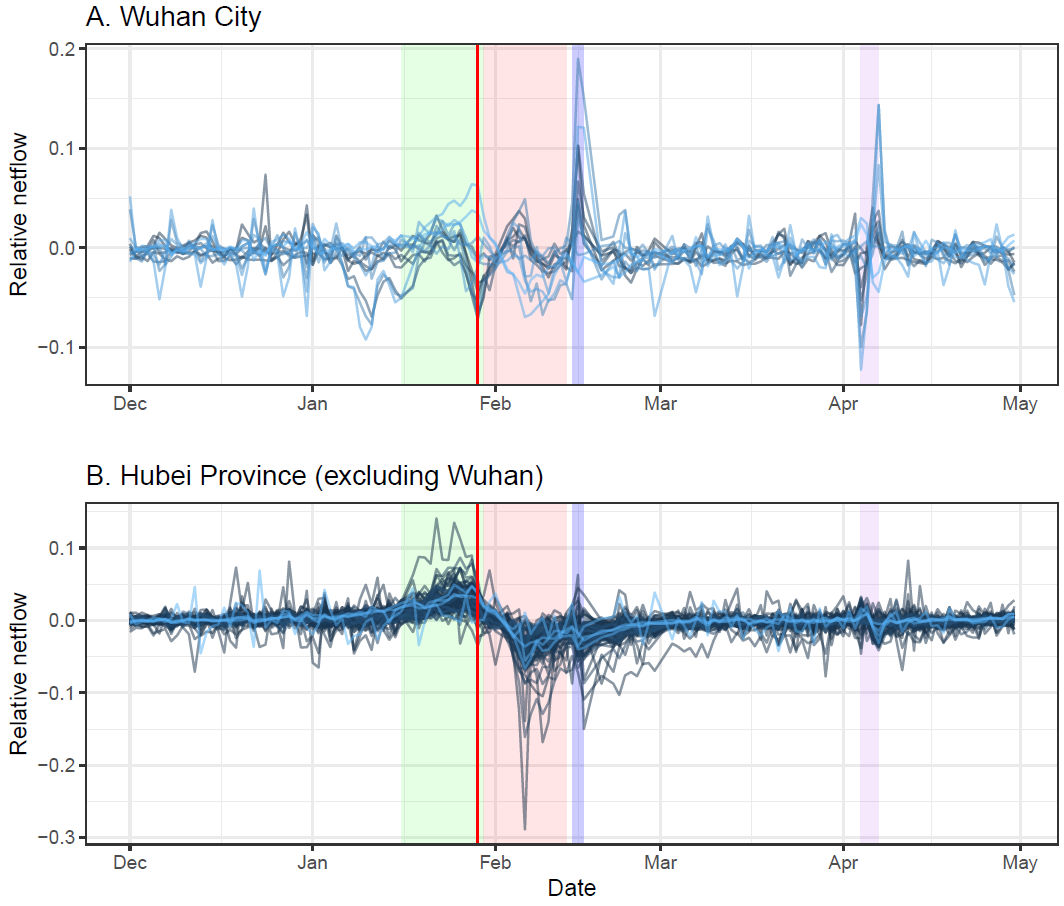
Figure 1. Patterns of daily human movement by county in Wuhan City and Hubei Province across six months.
Shadow colours:
- Green: 2 weeks before Lunar New Year’s Day;
- Red: 2 weeks since Lunar New Year’s Day;
- Purple: Lantern Festival;
- Pink: Tomb Sweeping Day;
- Red line: Lockdown day of cities in Hubei.
Relative netflow = (Inflow – Outflow)/population, based on the population movement data in 2013-2014 from Baidu, Inc.
Table 1. Top 30 ranked cities in mainland China receiving travellers from Wuhan during the two weeks before Lunar New Year’s Day.
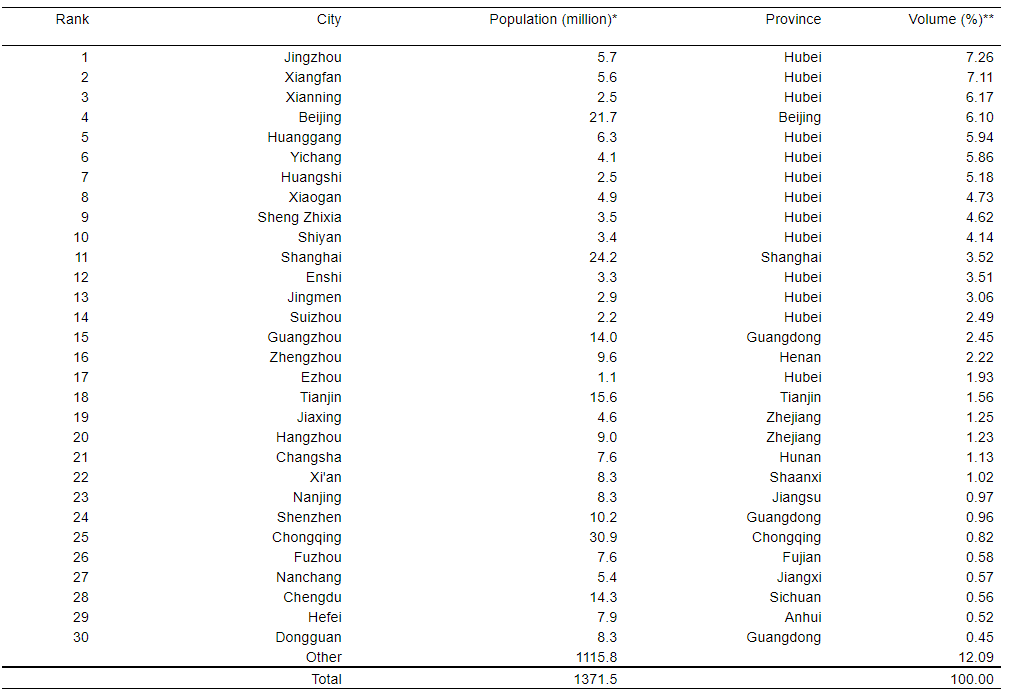
* 2016 population, National Bureau of Statistics, P.R. China.
** Percentage of travellers leaving Wuhan city within 2 weeks before the Lunar New Year in 2014 and 2015. Data were obtained from Baidu, Inc., a Chinese technology company specializing in Internet-related and location-based services with nearly 9 billion location requests each day.
Table 2. Top 30 ranked cities in mainland China receiving travellers from Wuhan during the two weeks since Lunar New Year’s Day.
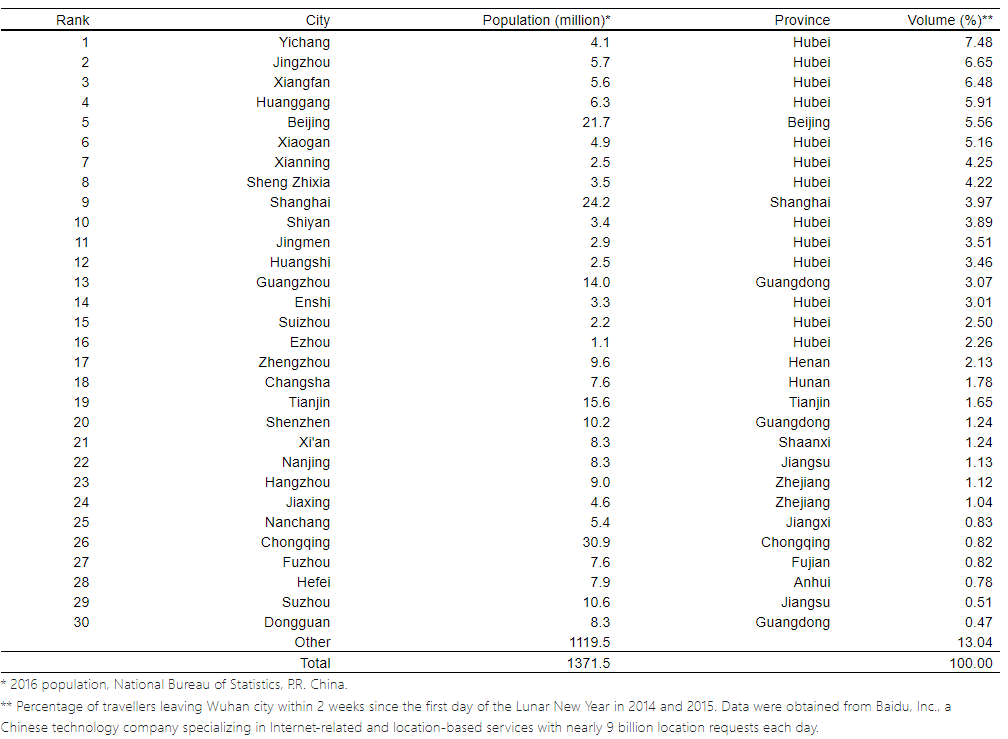
Table 3. The rank of provinces in mainland China receiving travellers from Wuhan city around Lunar New Year’s Day.
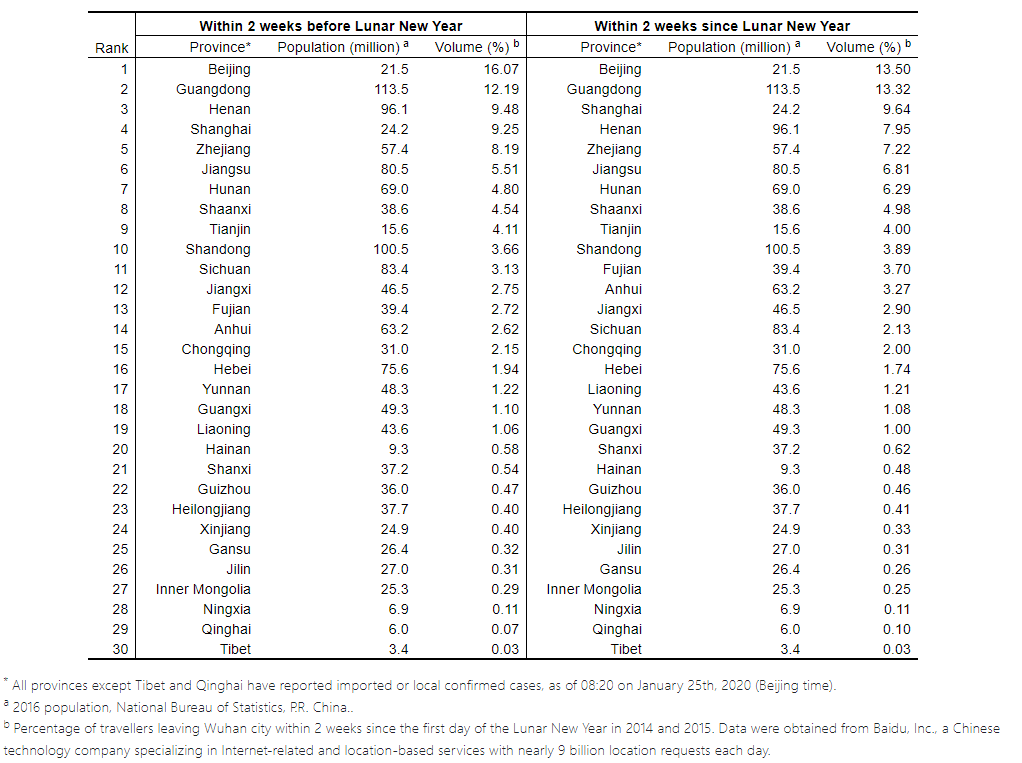
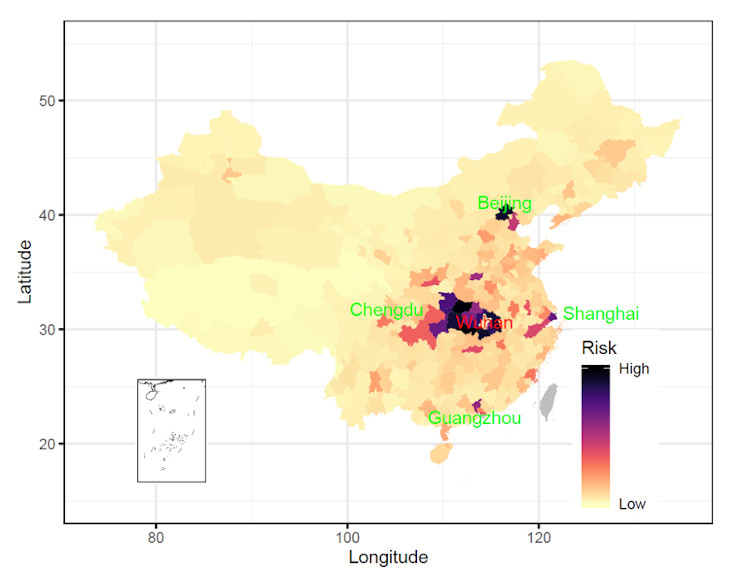 Figure 2. Risk of cities in mainland China receiving travellers with 2019-nCoV infections from Wuhan during the Lunar New Year migration.
Figure 2. Risk of cities in mainland China receiving travellers with 2019-nCoV infections from Wuhan during the Lunar New Year migration.
The risk of importation at city level was preliminarily defined as the percentage of travellers received by each city out of the total volume of travellers leaving Wuhan within 2 weeks before and since the first day of Lunar New Year, based on the population movement data from Baidu, Inc.
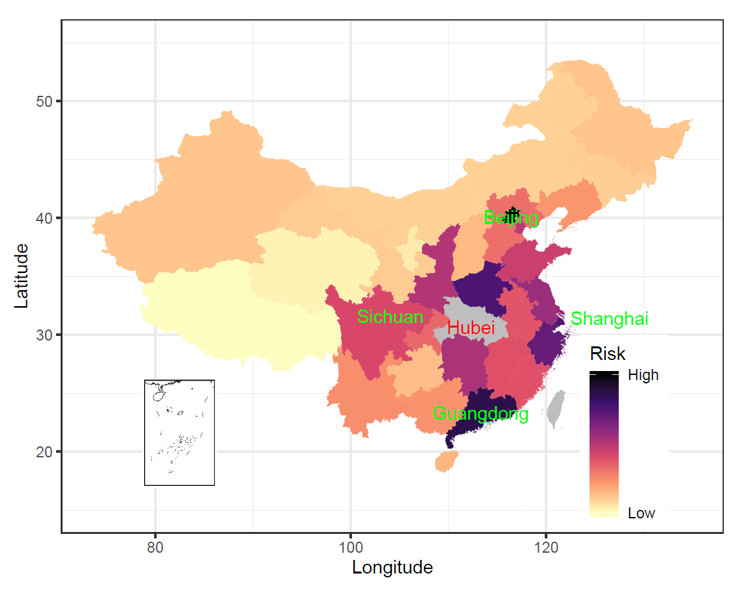 Figure 3. Risk of provinces in mainland China receiving travellers with 2019-nCoV infections from Wuhan during the Lunar New Year migration.
Figure 3. Risk of provinces in mainland China receiving travellers with 2019-nCoV infections from Wuhan during the Lunar New Year migration.
The risk of importation at provincial level was preliminarily defined as the percentage of travellers received by each province out of the total volume of travellers leaving Wuhan within 2 weeks before and since the first day of Lunar New Year, based on the population movement data from Baidu, Inc.
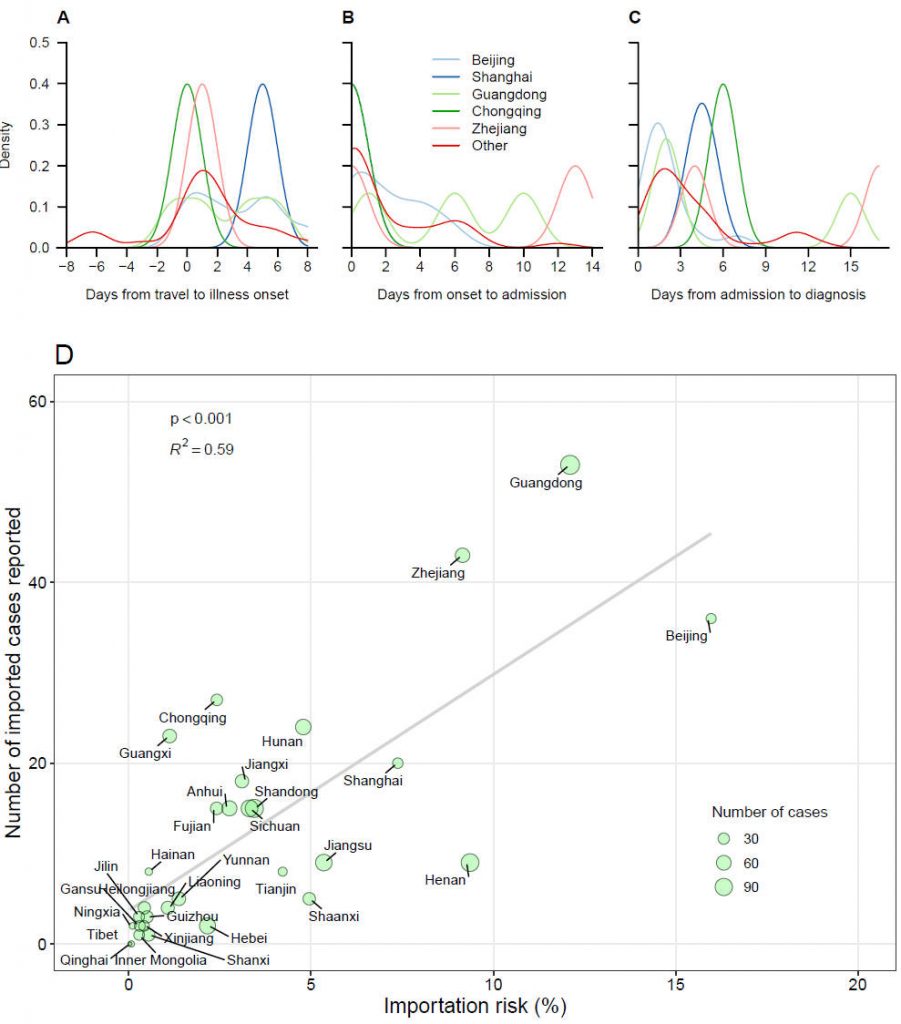 Figure 4. Time distributions of imported cases and correlation between the number of imported cases and the risk of importation via travellers from Wuhan within the two weeks before Lunar New Year’s Day.
Figure 4. Time distributions of imported cases and correlation between the number of imported cases and the risk of importation via travellers from Wuhan within the two weeks before Lunar New Year’s Day.
(A)-(C) The time distribution of imported cases travelling from Wuhan, illness onset, admission to hospital, and diagnosis by province. (D) correlation between the number of imported cases reported in each province and the risk of importation via travellers. The risk of importation at provincial level was preliminarily defined as the percentage of travellers received by each province out of the total volume of travellers leaving Wuhan within 2 weeks before and since the first day of Lunar New Year, based on the population movement data from Baidu, Inc. The data on cases as of January 24thip>, 2020, were obtained from the websites of Chinese National and Local Health Commissions.
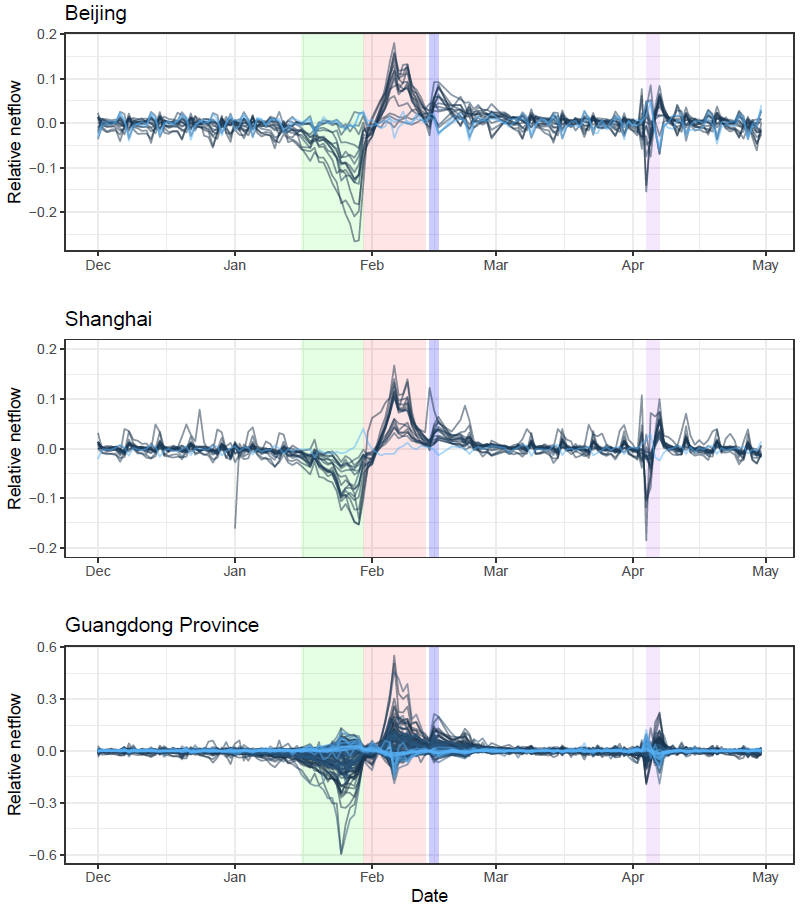 Figure 5. Patterns of daily human movement by county in Beijing, Shanghai, and Guangdong Province across six months.
Figure 5. Patterns of daily human movement by county in Beijing, Shanghai, and Guangdong Province across six months.
Shadow colours:
- Green: 2 weeks before Lunar New Year;
- Red: 2 weeks since Lunar New Year;
- Purple: Lantern Festival;
- Pink: Tomb Sweeping Day;
Relative netflow = (Inflow – Outflow)/population, based on the population movement data in 2013-2014 from Baidu, Inc.
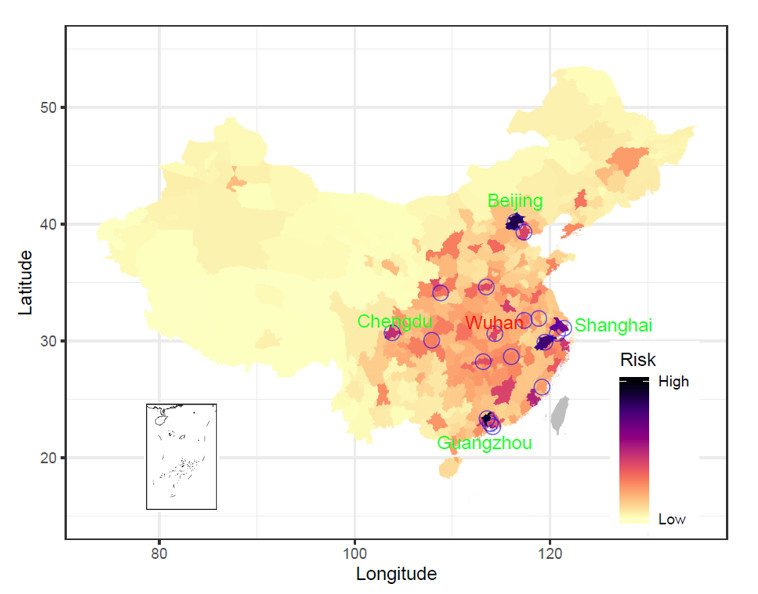 Figure 6. Risk of cities in mainland China receiving travellers from 18 high-risk cities (blue circles) with 2019-nCoV infections or importations during the next four weeks since Lunar New Year’s Day.
Figure 6. Risk of cities in mainland China receiving travellers from 18 high-risk cities (blue circles) with 2019-nCoV infections or importations during the next four weeks since Lunar New Year’s Day.
The risk of importation at city level was preliminarily defined as the averaged percentage of travellers received by each city out of the total volume of travellers leaving each high-risk city, based on the population movement data from Baidu, Inc.
18 high-risk cities include Wuhan and other 17 cities in other provinces receiving high volume of travellers from Wuhan before the Lunar New Year: Beijing, Shanghai, Guangzhou, Zhengzhou, Tianjin, Hangzhou, Jiaxing, Changsha, Xi’an, Nanjing, Shenzhen, Chongqing, Nanchang, Chengdu, Hefei, Fuzhou, Dongguan.
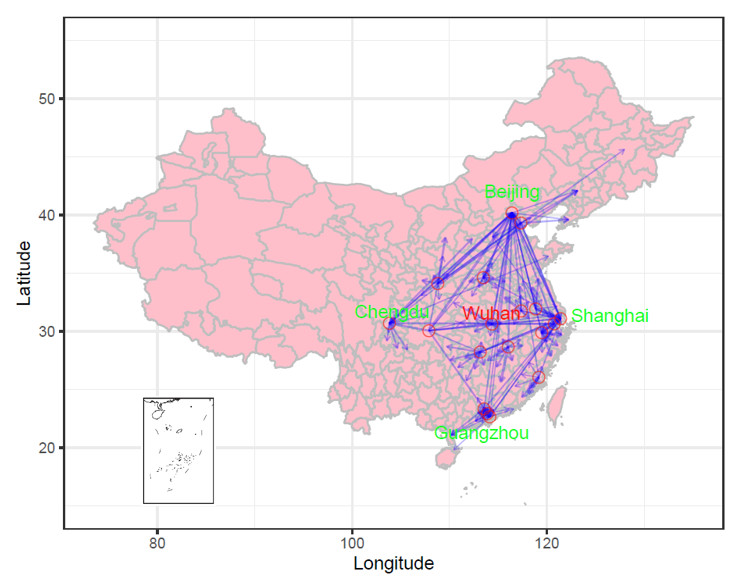 Figure 7. Estimated connectivity of cities in mainland China receiving travellers from 18 high-risk cities (blue circles) with 2019-nCoV infections or importations during the four weeks following Lunar New Year’s Day.
Figure 7. Estimated connectivity of cities in mainland China receiving travellers from 18 high-risk cities (blue circles) with 2019-nCoV infections or importations during the four weeks following Lunar New Year’s Day.
The arrows show the link and direction of the risk of importation at city level, preliminarily defined as the percentage of travellers received by each city (top 10 ranked cities) out of the total volume of travellers leaving each high-risk city (18 cities), based on the population movement data from Baidu, Inc.
18 high-risk cities: Wuhan in Wuhan Province and 17 cities (Beijing, Shanghai, Guangzhou, Zhengzhou, Tianjin, Hangzhou, Jiaxing, Changsha, Xi’an, Nanjing, Shenzhen, Chongqing, Nanchang, Chengdu, Hefei, Fuzhou, Dongguan) in other provinces receiving high volume of travellers from Wuhan before the Lunar New Year.
Section 2. International Travel
Table 4. Top 30 ranked cities across the globe receiving airline travellers from 18 high-risk cities (Figure 6) in mainland China over a period of three months, representing 15 days before Lunar New Year’s Day and 2 and half months following Lunar New Year’s Day.
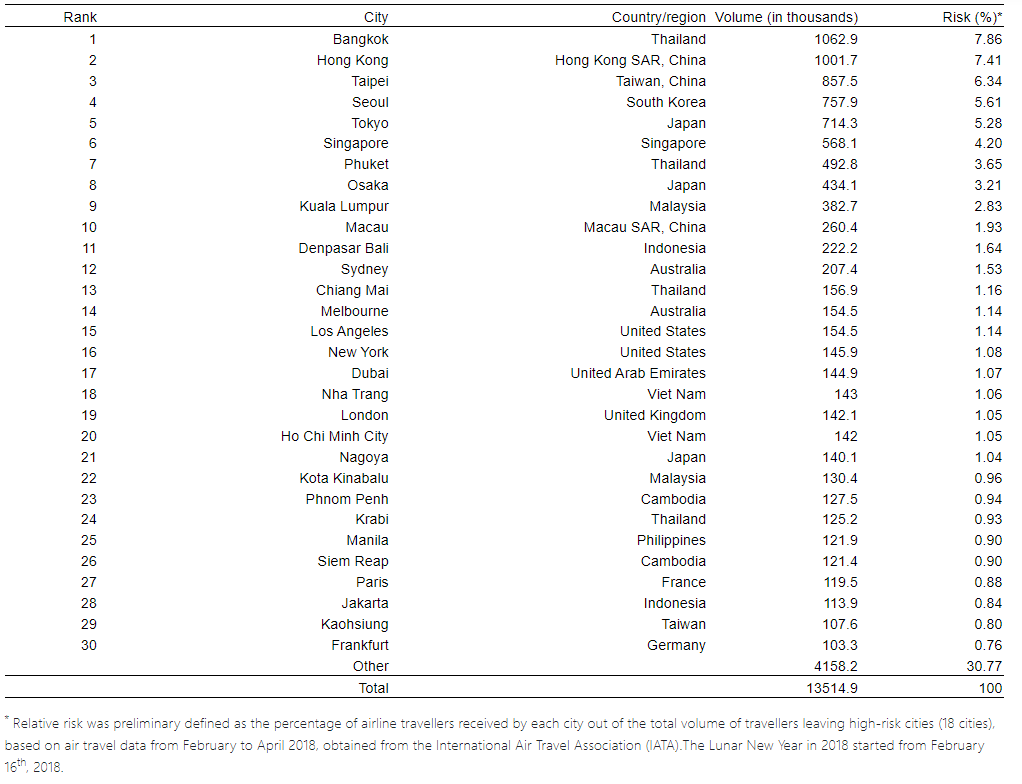
Table 5. Top 30 ranked countries or regions receiving airline travellers from 18 high-risk cities (Figure 6) in mainland China over a period of three months, representing 15 days before Lunar New Year’s Day and 2 and half months following Lunar New Year’s Day.
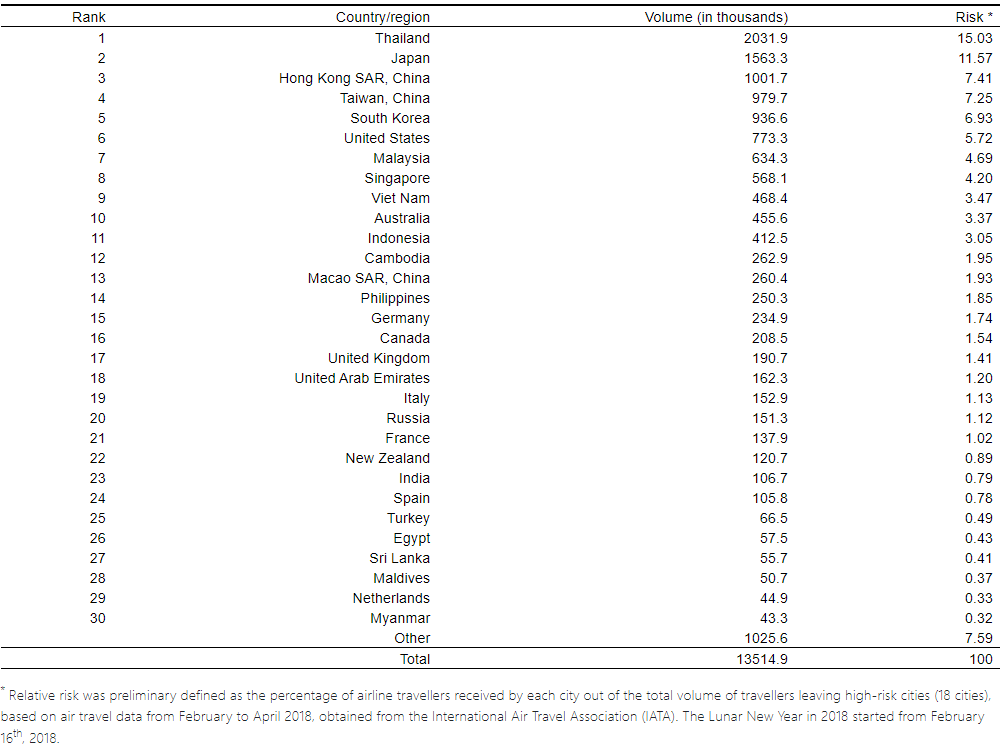
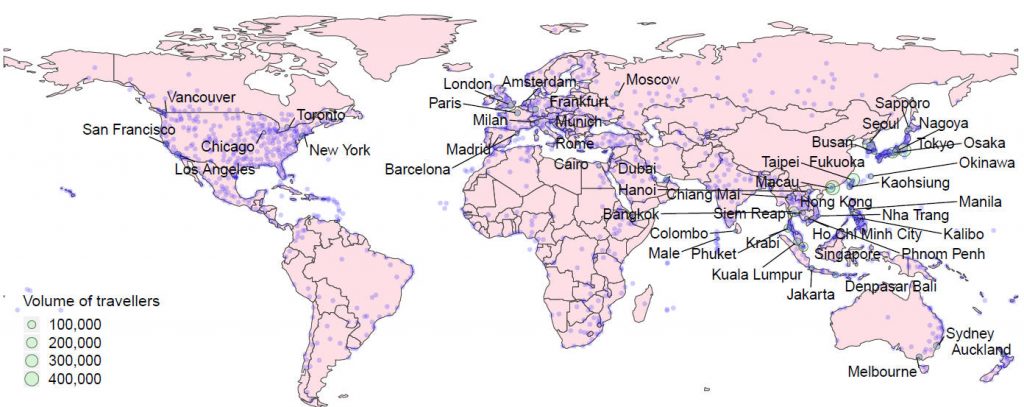
Figure 8. Geographic distribution of cities across the globe receiving airline travellers from 18 high-risk cities (Figure 6) in mainland China over a period of three months, representing 15 days before Lunar New Year’s Day and 2 and half months following Lunar New Year’s Day. The volume of airline travellers of the top 30 ranked cities is presented
Based on air travel data from February to April 2018, obtained from the International Air Travel Association (IATA). The Lunar New Year in 2018 started from February 16th, 2018.
Table 6. . Top 30 ranked cities in Africa receiving airline travellers from 18 high-risk cities (Figure 6) in mainland China over a period of three months, representing 15 days before Lunar New Year’s Day and 2 and half months following Lunar New Year’s Day.
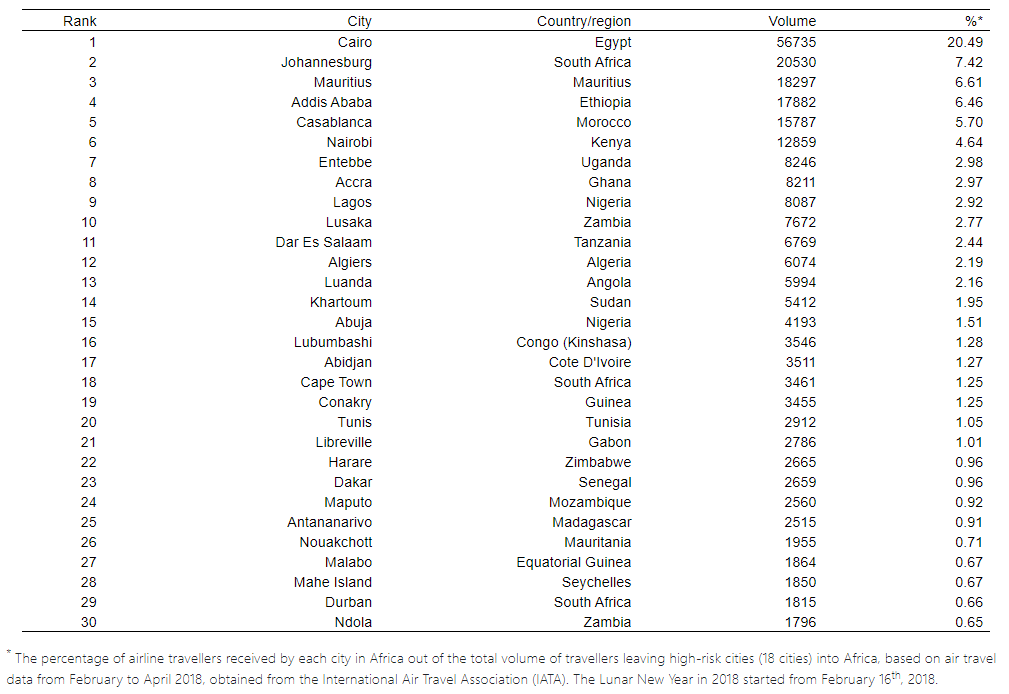
Table 7. African countries or territories receiving airline travellers from 18 high-risk cities (Figure 6) in mainland China over a period of three months, representing 15 days before Lunar New Year’s Day and 2 and half months following Lunar New Year’s Day.
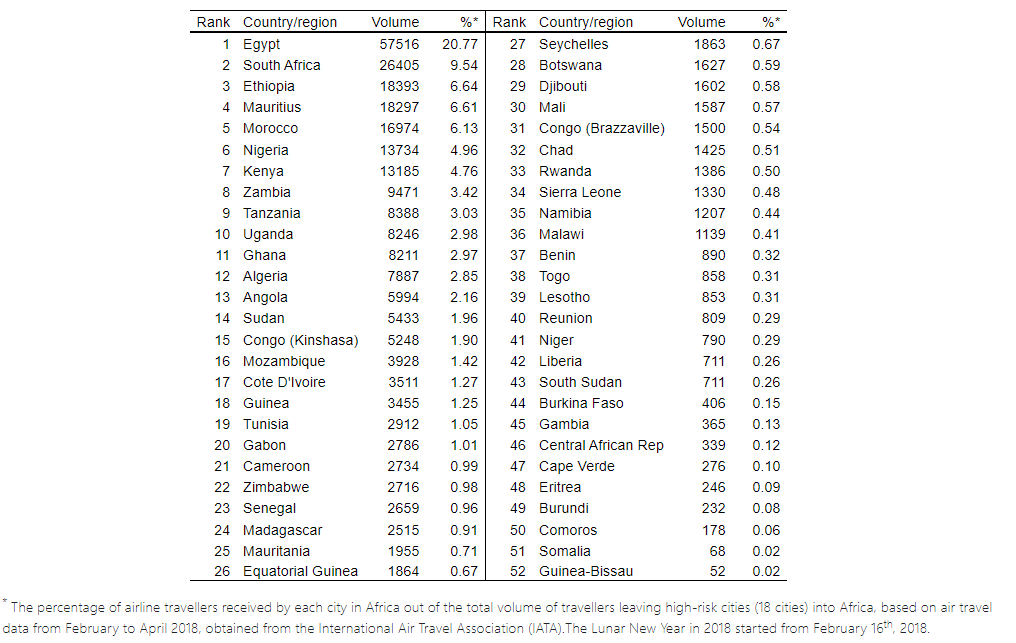
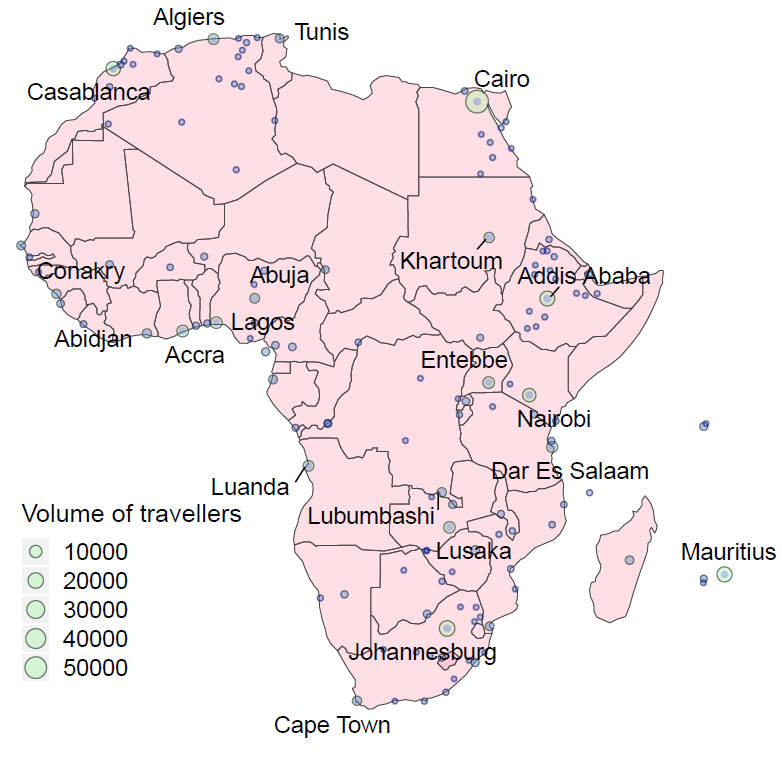 Figure 3. Geographic distribution of African cities receiving airline travellers from 18 high-risk cities (Figure 6) in mainland China over a period of three months, representing 15 days before Lunar New Year’s Day and 2 and half months following Lunar New Year’s Day.
Figure 3. Geographic distribution of African cities receiving airline travellers from 18 high-risk cities (Figure 6) in mainland China over a period of three months, representing 15 days before Lunar New Year’s Day and 2 and half months following Lunar New Year’s Day.
Based on air travel data from February to April 2018, obtained from the International Air Travel Association (IATA). The Lunar New Year in 2018 started from February 16th, 2018.
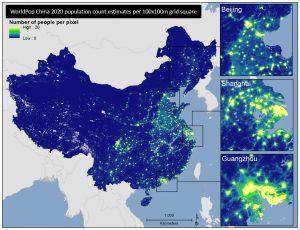 WorldPop China datasets
WorldPop China datasets
WorldPop China datasets are available to download here


